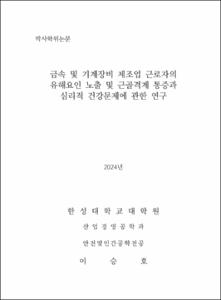금속 및 기계장비 제조업 근로자의 유해요인 노출 및 근골격계 통증과 심리적 건강문제에 관한 연구
= A Study of Exposure to Hazard Factors, Musculoskeletal Pain, and Psychological Health Problems of Metal and Mechanical Equipment Manufacturing Workers
- Files in This Item:
-
-
Download
 200000726236.pdf
기타 데이터 / 1.55 MB / Adobe PDF
200000726236.pdf
기타 데이터 / 1.55 MB / Adobe PDF
-
Items in Repository are protected by copyright, with all rights reserved, unless otherwise indicated.